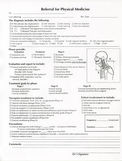| |
|
 |

Click the image of each document to view as a downloadable PDF
 | WHEN DOES A PATIENT NEED A "FUNCTIONAL ANALYSIS" OF THEIR DENTAL OCCLUSION?
Diagnostic mounted models are one of the most valuable, yet underutilized, aids that a dentist has available for evaluating a patient's dental occlusion. This pamphlet describes when this diagnostic procedure should be considered to obtain accurate records. |
 | MASTICATORY PAIN ("TMJ") and RELATED HEADACHES
A Discussion for Non-Dental Health Professionals
Non-dental health care professionals often have little basis for appreciating the unique physiology and function of the masticatory system. This pamphlet briefly describes the ways in which this joint system differs from others in the human body and how its function can be adversely altered to produce the symptoms commonly known as "TMJ". |
 | MASTICATORY SCREENING HISTORY & EXAM FORM
(Includes a form that explains how to interpret the results)
Identifying patients with temporomandibular disorders at the earliest possible stage is best done by incorporating a screening protocol into routine recall appointments. This screening form provides a means of collecting the necessary data to make an early preliminary diagnosis. |
 | MASTICATORY PAIN/DYSFUNCTION HISTORY
A biologically-based diagnosis of masticatory pain/dysfunction ("TMJ") requires taking a thorough history. This history form covers not just issues related to masticatory function, but also other medical and dental factors that can be significant in understanding the nature of the patient's problem. |
 | COMPREHENSIVE MASTICATORY EXAMINATION
Achieving a biologically-based diagnosis of masticatory function requires a comprehensive examination of the patient. This three-page form is organized into twelve sections and provides clear guidance for recording all relevant findings related to the patient's problem. |
 | MASTICATORY DIAGNOSIS FORM
This form lists all of the potential diagnoses that might apply to a patient with masticatory pain / dysfunction, together with their ICD code numbers. In addition, a number of other medical diagnoses, that may have been previously made by the patient's physician, are listed, with their appropriate ICD codes. |
 | PHYSICAL MEDICINE REFERRAL FORM
This form is designed to facilitate the referral of a patient to a Physical Medicine Specialist (Physical Therapy, Chiropractic, Massage Therapy, etc.) by specifying a diagnosis and specific instructions. |
 | TRIGGER POINT REFERRAL PATTERN FORM
Pain in the orofacial region can be a result of referral patterns from myofascial trigger points. When these trigger points are located and confirmed as the source of pain at specific locations, they need to be documented. This form provides the means of recording trigger points when the have been identified. |
 | PATIENT SELF-ASSESSMENT OF OCCLUSAL CONDITION
Standard assessment of a patient's occlusal condition typically leaves out one important consideration — the patient's own assessment of their occlusal condition. This simple questionnaire allows the patient to provide information, based on their own perception, of factors that may not be apparent by the usual methods of occlusal assessment. |
 | IMAGING REQUEST FORM
A request for imaging from an outside facility requires clear instructions. Different types of imaging require different technology as well as technique-specific procedures. This form is designed to allow a request to be made quickly and with clarity that the radiology technician will understand. |
 | TMD HISTORY & EXAM SUMMARY FORM (prototype)
Often an insurance company will request information regarding a patient with a temporomandibular disorder. This form, when completed, will provide the requested information. The form shown here is a prototype. Each clinician will need to create their own, using their individual practice information. |

|
|





